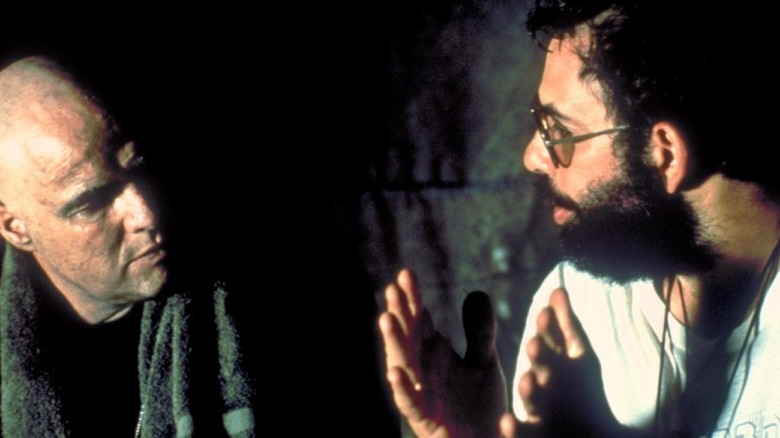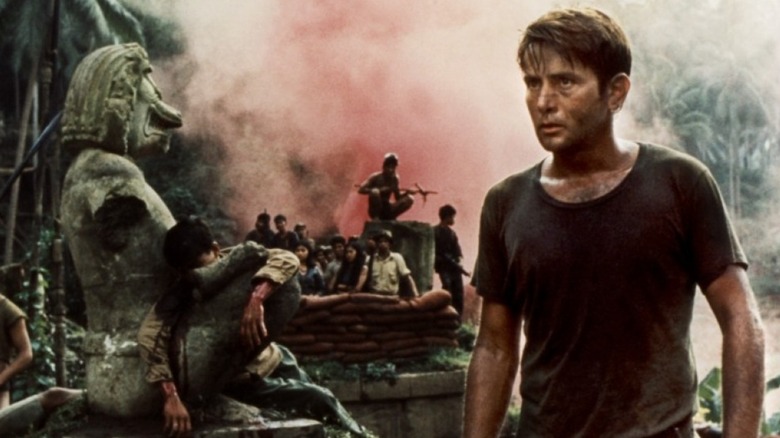A Natural Disaster On The Apocalypse Now Set Nearly Killed The Movie's Director
Few productions have been as troubled and chaotic as Francis Ford Coppola's epic war film, "Apocalypse Now." For starters, the lead had to be recast halfway through filming, shoots were postponed due to unforeseen reasons, and real-life sociopolitical factors constantly interfered with the projected schedule. This, however, was just the tip of the "Apocalypse Now" iceberg. The true extent of the horrors documented in "Hearts of Darkness: A Filmmaker's Apocalypse" highlights the uncomfortably tense environment on set, exacerbated by interpersonal clashes, health issues/hygiene concerns, and extreme weather. To say that things took a hellish turn would be an understatement, but Coppola and co. had no option but to power through.
To make matters worse, Typhoon Olga hit the Philippines in 1976, displacing over 1.3 million of the local population and destroying everything in its path. Coppola's production was heavily impacted as a result, as the typhoon destroyed elaborate film sets/equipment, which added further strain on an already expanding budget. According to veteran actor Scott Glenn (who plays Captain Richard M. Colby in the film), the typhoon nearly took Coppola's life (!!!) while they were filming in Ulugan Bay. Speaking to The Hollywood Reporter, Glenn recounted how he had instinctively averted a possible catastrophe and saved Coppola's life with some quick thinking:
"That night, Typhoon Didang [also known as Olga] — the worst storm since 1932 — tore straight through us. It turned the isthmus where we were staying into an island. Francis had climbed into a dugout canoe, which was tied to a rope on shore. From 50 yards away, I could see exactly what was about to happen: the current would pull the boat downstream, the rope would snap tight, and the stern would go under. Instinct kicked in. I sprinted, pulled out my Marine knife, and cut the rope just as it went taut. The boat drifted downstream, but they made it back. That night, Francis said, 'You saved my life.' I told him, 'I cut a rope.'"
Coppola was immensely grateful and offered Glenn the choice to pick any scene that would allow his character to do more than what the existing script accommodated. Glenn opted for more screentime at the end of the movie, even though Colby didn't have too many speaking lines. "I wanted to be near [Marlon] Brando, [Dennis] Hopper, all of them. So I took it. Best decision I ever made," Glenn stated, looking back positively on the experience.
The making of Apocalypse Now is infamous and controversial for a reason
The controversies surrounding the making of "Apocalypse Now" are complex and multifaceted. Less-than-ideal decisions were made by everyone on set, but most of the setbacks couldn't be anticipated or controlled. For example, the government assets that were used for filming, such as helicopters, were constantly recalled by the President to fight insurgent forces, leaving trained Filipino pilots no choice but to oblige. What's more, most of the sets were constructed in the tropical jungles (which led to working conditions that were difficult enough), but an alarming lack of safety measures made things decidedly worse. Per The Independent, the flare explosions and colored smoke featured in the story had to be done practically, making things "extremely dangerous" for the construction crew and everyone involved.
Amid actor-related shenanigans (where some, like Dennis Hopper, went full method and didn't shower for weeks, and others, like Marlon Brando, arrived completely unprepared on set), Coppola's production had officially gone off the rails. After replacing Harvey Keitel, Martin Sheen (who plays the veteran assassin, Captain Benjamin L. Willard) had to acclimatize to the chaos on set while dealing with his own problems, and the actor suffered a near-fatal heart attack during production. Coppola also suffered an epileptic seizure at one point, highlighting the very real dangers of working under such extreme conditions.
This is only a brief glimpse into the problematic making of "Apocalypse Now" — by the time production finally wrapped up, the budget had ballooned from $12 million to over $30 million (the fact that Coppola self-financed a chunk of it certainly didn't help matters). The director also had to edit over a million feet of film, which must've been an arduous ordeal in itself, adding to the infamously complicated legacy of such a culturally significant piece of art.

